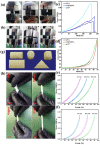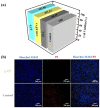Excellent Dark/Light Dual-Mode Photoresponsive Activities Based on g-C3N4/CMCh/PVA Nanocomposite Hydrogel Using Electron Beam Radiation Method
- PMID: 38005263
- PMCID: PMC10674341
- DOI: 10.3390/molecules28227544
Excellent Dark/Light Dual-Mode Photoresponsive Activities Based on g-C3N4/CMCh/PVA Nanocomposite Hydrogel Using Electron Beam Radiation Method
Abstract
Photocatalytic technology for inactivating bacteria in water has received much attention. In this study, we reported a dark-light dual-mode sterilized g-C3N4/chitosan/poly (vinyl alcohol) hydrogel (g-CP) prepared through freeze-thaw cycling and an in situ electron-beam radiation method. The structures and morphologies of g-CP were confirmed using Fourier infrared spectroscopy (FTIR), X-ray diffraction spectroscopy (XRD), X-ray photoelectron spectroscopy (XPS), scanning electron microscopy (SEM), solid ultraviolet diffuse reflectance spectroscopy (UV-vis DRS), and Brunauer-Emmett-Teller (BET). Photocatalytic degradation experiments demonstrated that 1 wt% g-CP degraded rhodamine B (RhB) up to 65.92% in 60 min. At the same time, g-CP had good antimicrobial abilities for Escherichia coli (E. coli) and Staphylococcus aureus (S. aureus) within 4 h. The shapes of g-CP were adjustable (such as bar, cylinder, and cube) and had good mechanical properties and biocompatibility. The tensile and compressive modulus of 2 wt% g-CP were 0.093 MPa and 1.61 MPa, respectively. The Cell Counting Kit-8 (CCK-8) test and Hoechst33342/PI double staining were used to prove that g-CP had good biocompatibility. It is expected to be applied to environmental sewage treatment and wound dressing in the future.
Keywords: cell activity; electron beam radiation method; g-CP hydrogel; photocatalytic antibacterial; photocatalytic degradation.
Conflict of interest statement
The authors declare no conflict of interest.
Figures










Similar articles
-
Enhanced visible-light-driven photocatalytic disinfection using AgBr-modified g-C3N4 composite and its mechanism.Colloids Surf B Biointerfaces. 2019 Jul 1;179:170-179. doi: 10.1016/j.colsurfb.2019.03.074. Epub 2019 Apr 2. Colloids Surf B Biointerfaces. 2019. PMID: 30959229
-
Construction of a novel double S-scheme structure WO3/g-C3N4/BiOI: Enhanced photocatalytic performance for antibacterial activity.J Colloid Interface Sci. 2023 Mar;633:60-71. doi: 10.1016/j.jcis.2022.11.058. Epub 2022 Nov 16. J Colloid Interface Sci. 2023. PMID: 36434936
-
Fullerene modified C3N4 composites with enhanced photocatalytic activity under visible light irradiation.Dalton Trans. 2014 Jan 21;43(3):982-9. doi: 10.1039/c3dt52454j. Epub 2013 Oct 25. Dalton Trans. 2014. PMID: 24162386
-
Design of a direct Z-scheme photocatalyst: preparation and characterization of Bi₂O₃/g-C₃N₄ with high visible light activity.J Hazard Mater. 2014 Sep 15;280:713-22. doi: 10.1016/j.jhazmat.2014.08.055. Epub 2014 Sep 3. J Hazard Mater. 2014. PMID: 25232654
-
Synthesis of Bi2O3/g-C3N4 for enhanced photocatalytic CO2 reduction with a Z-scheme mechanism.RSC Adv. 2019 Nov 13;9(64):37162-37170. doi: 10.1039/c9ra07485f. eCollection 2019 Nov 13. RSC Adv. 2019. PMID: 35542275 Free PMC article.
Cited by
-
Z-Scheme Heterojunction of Phosphorus-Doped Carbon Nitride/Titanium Dioxide: Photocatalytic Performance.Molecules. 2024 Sep 12;29(18):4342. doi: 10.3390/molecules29184342. Molecules. 2024. PMID: 39339336 Free PMC article.
-
Ionizing Radiation Crosslinked Chitosan-Based Hydrogels for Environmental Remediation.Gels. 2025 Jun 25;11(7):492. doi: 10.3390/gels11070492. Gels. 2025. PMID: 40710653 Free PMC article. Review.
-
Adsorption Behaviors of ctDNA and Biological Activities Based on Polyvinyl Alcohol/Polyethylene Glycol/Quaternized Chitosan Composite Hydrogel.Molecules. 2024 Dec 6;29(23):5770. doi: 10.3390/molecules29235770. Molecules. 2024. PMID: 39683926 Free PMC article.
References
-
- Sudhaik A., Raizada P., Ahamad T., Alshehri S.M., Nguyen V., Le Q.V., Thakur S., Thakur V.K., Selvasembian R., Singh P. Recent advances in cellulose supported photocatalysis for pollutant mitigation: A review. Int. J. Biol. Macromol. 2022;226:1284–1308. doi: 10.1016/j.ijbiomac.2022.11.241. - DOI - PubMed
-
- Li Y.F., Xia Z., Yang Q., Wang L., Xing Y. Review on g-C3N4-based S-scheme heterojunction photocatalysts. J. Mater. Sci. Technol. 2022;125:128–144. doi: 10.1016/j.jmst.2022.02.035. - DOI
-
- Ren Y., Huang T., Zhao X., Wang K., Zhao L., Tao A., Jiang J., Yuan M., Wang J., Tu Q. Double network hydrogel based on curdlan and flaxseed gum with photothermal antibacterial properties for accelerating infectious wound healing. Int. J. Biol. Macromol. 2023;242:124715. doi: 10.1016/j.ijbiomac.2023.124715. - DOI - PubMed
-
- Xie X.F., Lei H., Fan D. Antibacterial hydrogel with pH-responsive microcarriers of slow-release VEGF for bacterial infected wounds repair. J. Mater. Sci. Technol. 2023;144:198–212. doi: 10.1016/j.jmst.2022.09.062. - DOI
MeSH terms
Substances
Grants and funding
- No. 2021GXYF021/the Key R&D Plan of Hubei Provincial Department of Science and Technology Hubei Provincial Colleges and Universities Outstanding Young and Middle-aged Technological Innovation Team Project Xianning City Key Program of Science & Technology
- No.T2020022/Hubei Provincial Colleges and Universities Outstanding Young and Middle-aged Technological Innovation Team Project
- No. 2021GXYF021/Xianning City Key Program of Science & Technology
- No.2020TD01, 2022FH09/the Science Development Foundation of Hubei University of Science & Technology
LinkOut - more resources
Full Text Sources
Research Materials
Miscellaneous

